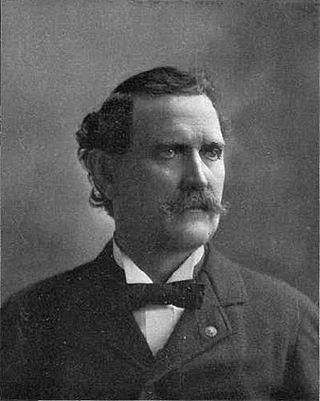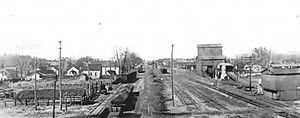
Virden is a city in Macoupin and Sangamon counties in the U.S. state of Illinois. The population was 3,231 at the 2020 census.

The United Mine Workers of America is a North American labor union best known for representing coal miners. Today, the Union also represents health care workers, truck drivers, manufacturing workers and public employees in the United States and Canada. Although its main focus has always been on workers and their rights, the UMW of today also advocates for better roads, schools, and universal health care. By 2014, coal mining had largely shifted to open pit mines in Wyoming, and there were only 60,000 active coal miners. The UMW was left with 35,000 members, of whom 20,000 were coal miners, chiefly in underground mines in Kentucky and West Virginia. However it was responsible for pensions and medical benefits for 40,000 retired miners, and for 50,000 spouses and dependents.

John Riley Tanner was the 21st Governor of Illinois, from 1897 until 1901.

A strikebreaker is a person who works despite a strike. Strikebreakers are usually individuals who were not employed by the company before the trade union dispute but hired after or during the strike to keep the organization running. Strikebreakers may also refer to workers who cross picket lines to work.

The Great Railroad Strike of 1922, or the Railway Shopmen's Strike, was a nationwide strike of railroad workers in the United States. Launched on July 1, 1922 by seven of the sixteen extant railroad labor organizations, the strike continued into August before collapsing. A sweeping judicial injunction by Judge James Herbert Wilkerson effectively ended the strike on September 1, 1922.

The Herrin massacre took place on June 21–22, 1922 in Herrin, Illinois, in a coal mining area during a nationwide strike by the United Mineworkers of America (UMWA). Although the owner of the mine originally agreed with the union to observe the strike, when the price of coal went up, he hired non-union workers to produce and ship out coal, as he had high debt in start-up costs.

The Paint Creek–Cabin Creek Strike, or the Paint Creek Mine War, was a confrontation between striking coal miners and coal operators in Kanawha County, West Virginia, centered on the area enclosed by two streams, Paint Creek and Cabin Creek.
The Westmoreland County coal strike of 1910–1911, or the Westmoreland coal miners' strike, was a strike by coal miners represented by the United Mine Workers of America. The strike is also known as the Slovak Strike because about 70 percent of the miners were Slovak immigrants. It began in Westmoreland County, Pennsylvania, on March 9, 1910, and ended on July 1, 1911. At its height, the strike encompassed 65 mines and 15,000 coal miners. Sixteen people were killed during the strike, nearly all of them striking miners or members of their families. The strike ended in defeat for the union.
Labor spying in the United States had involved people recruited or employed for the purpose of gathering intelligence, committing sabotage, sowing dissent, or engaging in other similar activities, in the context of an employer/labor organization relationship. Spying by companies on union activities has been illegal in the United States since the National Labor Relations Act of 1935. However, non-union monitoring of employee activities while at work is perfectly legal and, according to the American Management Association, nearly 80% of major US companies actively monitor their employees.

The 1892 Coeur d'Alene labor strike erupted in violence when labor union miners discovered they had been infiltrated by a Pinkerton agent who had routinely provided union information to the mine owners. The response to the labor violence, disastrous for the local miners' union, became the primary motivation for the formation of the Western Federation of Miners (WFM) the following year. The incident marked the first violent confrontation between the workers of the mines and their owners. Labor unrest continued after the 1892 strike, and surfaced again in the labor confrontation of 1899.

Anti-union violence is physical force intended to harm union officials, union organizers, union members, union sympathizers, or their families. It is most commonly used either during union organizing efforts, or during strikes. The aim most often is to prevent a union from forming, to destroy an existing union, or to reduce the effectiveness of a union or a particular strike action. If strikers prevent people or goods to enter or leave a workplace, violence may be used to allow people and goods to pass the picket line.
The Pana riot, or Pana massacre, was a coal mining labor conflict and also a racial conflict that occurred on April 10, 1899, in Pana, Illinois, and resulted in the deaths of seven people. It was one of many similar labor conflicts in the coal mining regions of Illinois that occurred in 1898 and 1899.

The Colorado Coalfield War was a major labor uprising in the southern and central Colorado Front Range between September 1913 and December 1914. Striking began in late summer 1913, organized by the United Mine Workers of America (UMWA) against the Rockefeller-owned Colorado Fuel and Iron (CF&I) after years of deadly working conditions and low pay. The strike was marred by targeted and indiscriminate attacks from both strikers and individuals hired by CF&I to defend its property. Fighting was focused in the southern coal-mining counties of Las Animas and Huerfano, where the Colorado and Southern railroad passed through Trinidad and Walsenburg. It followed the 1912 Northern Colorado Coalfield Strikes.

The Illinois coal wars, also known as the Illinois mine wars and several other names, were a series of labor disputes between 1898 and 1900 in central and southern Illinois.
The Carbon County Strikes took place in Carbon County, Utah from 1903–1904. The strikes primarily consisted of Slavic and Italian immigrant mine workers who partnered with the United Mine Workers of America strikes in Colorado to protest the dangerous working conditions of the Utah coal mines. The Carbon County strikes were considered the most important labor confrontation in the United States at the time. The Utah Fuel Company strongly opposed initiatives to unionize coal workers in Utah and were the primary opposition to the UMWA at the time. The Carbon County Strikes would ultimately fail in its attempt to unionize the coal workers of Utah simply because it "did not have enough support, either internally or externally, to win against a powerful and influential company that effectively played on radical, anti-foreign sentiments in defending its position" but it demonstrated a significant nationwide effort in strengthening unionization in the west.

Anti-union violence in the United States is physical force intended to harm union officials, union organizers, union members, union sympathizers, or their families. It has most commonly been used either during union organizing efforts, or during strikes. The aim most often is to prevent a union from forming, to destroy an existing union, or to reduce the effectiveness of a union or a particular strike action. If strikers prevent people or goods to enter or leave a workplace, violence may be used to allow people and goods to pass the picket line.
When union violence has occurred, it has frequently been in the context of industrial unrest. Violence has ranged from isolated acts by individuals to wider campaigns of organised violence aimed at furthering union goals within an industrial dispute.
The Spring Valley race riot of 1895 was a violent racial conflict between Eastern and Southern European immigrants and African American coal workers in the mining town of Spring Valley, Illinois. The conflict was in response to the robbery and shooting of Italian miner Barney Rollo, who reported that his assailants were five black men. The assault provoked the town's long-standing social and racial unrest, and many white immigrant workers united against the African American miners. During the investigation into the shooting several black miners were temporarily taken into custody for questioning and many white townspeople began to form a mob, demanding that all blacks be fired and removed from Spring Valley. The mine manager refused, which prompted the white miners to violently riot against both the black miners and their families, forcing them to flee to the nearby town of Princeton.
The Carterville Mine Riot was part of the turn-of-the-century Illinois coal wars in the United States. The national United Mine Workers of America coal strike of 1897 was officially settled for Illinois District 12 in January 1898, with the vast majority of operators accepting the union terms: thirty-six to forty cents per ton, an 8-hour day, and union recognition. However, several mine owners in Carterville, Virden, and Pana, refused or abrogated. They attempted to run with African-American strikebreakers from Alabama and Tennessee. At the same time, lynching and racial exclusion were increasingly practiced by local white mining communities. Racial segregation was enforced within and among UMWA-organized coal mines.
The lynching of F. W. Stewart occurred shortly after midnight on November 7, 1898, about a mile outside of Lacon, Illinois. Stewart had been accused of the assault of a miner's daughter in Toluca. About one hundred miners formed a mob and broke into the Marshall County jail to retrieve Stewart, whom they hanged.














